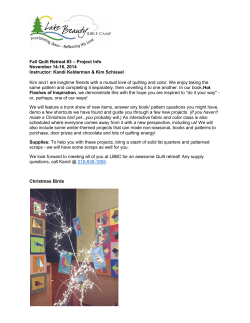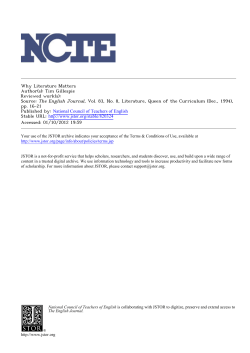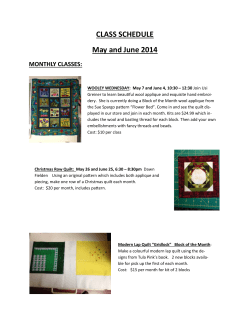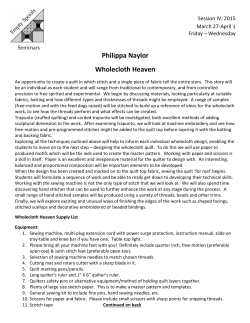
Stitching Quilts into Coordinate Geometry Author(s): Susanne K. Westegaard Source:
Stitching Quilts into Coordinate Geometry Author(s): Susanne K. Westegaard Source: The Mathematics Teacher, Vol. 91, No. 7 (October 1998), pp. 587-592, 598-600 Published by: National Council of Teachers of Mathematics Stable URL: http://www.jstor.org/stable/27970690 . Accessed: 05/07/2013 12:16 Your use of the JSTOR archive indicates your acceptance of the Terms & Conditions of Use, available at . http://www.jstor.org/page/info/about/policies/terms.jsp . JSTOR is a not-for-profit service that helps scholars, researchers, and students discover, use, and build upon a wide range of content in a trusted digital archive. We use information technology and tools to increase productivity and facilitate new forms of scholarship. For more information about JSTOR, please contact support@jstor.org. . National Council of Teachers of Mathematics is collaborating with JSTOR to digitize, preserve and extend access to The Mathematics Teacher. http://www.jstor.org This content downloaded from 150.131.74.79 on Fri, 5 Jul 2013 12:16:24 PM All use subject to JSTOR Terms and Conditions > Activities into Coordinate Quilts Stitching Quilts?useful items, visually appealing, steeped in history, and an integral part of our culture?can also be the jumping-off point formany mathematical investigations" (Morrow and Bassarear 1996). The history behind many quilt patterns offersan opportunity for cross disciplinary projects with art and social studies classes. Such children's books as Eight Hands Round (Paul 1991)andSelina and theBearPaw Quilt (Smucker 1995) connectmathematics with literature. TEACHER'S GUIDE When my mother asked me to enlarge a quilt-block pattern forher, I explored transferringthe pattern onto a coordinate grid as well as using compass and-straightedge construction.The coordinate-grid method seemed far easier. I could not locate formy class activities that reinforced "writingequations for lines/' so I used quilt patterns to develop activity sheets for students and a project to accompany the activity sheets. These activities reinforce coordinate-geometry concepts?coordinates, positive and negative slopes, intercepts, and equations forhorizontal and vertical lines. For group discussion, this article includes questions and prompts thatwill lead stu dents to notions of probability, area, and geometry. These activities can be used with small groups, individuals, or large groups. Prerequisites: These coordinate-geometryactivi ties can be used with students who are familiar with coordinates, slope, and equations for lines. This article includes suggestions formodifications and extensions. Grade levels: 7-12 Susanne . Westegaard Geometry Sheet1:This sheetdealswitha quiltblockthatis located only in the firstquadrant. Less mathemati callymature students, or students who need an introductoryactivity, could be asked to label all the vertices and find the slope of each segment.More advanced students could be also asked towrite re < < 3, foreach segment. strictions, forexample, 0 is Of vital importance connecting this activity to such other ideas as geometric shapes, probability, and area. Ask students to find the following geometric shapes: triangle, square, rectangle, par allelogram, trapezoid, hexagon, right triangle, isosceles triangle, and regular octagon, as well as a pair of congruent triangles or congruent squares. This activity can become open-ended by asking the students to find as many geometric shapes as they can. Students could be asked the followingques tions:How many triangles can you find?How many squares? How many trapezoids? How many rectan gles? Are any shapes similar? Students can find the area of each polygon. The many possible probability questions include the following: If a coordinate pair is chosen at ran of what is theprobability domfrom theblock, selecting a pair in the shaded square? What is the probability of selecting a pair in a shaded triangle? a pair ina What is theprobability ofselecting a ofselecting What is theprobability shadedfigure? pair in a shaded triangle ifyou select a shaded fig ure? The probability questions could be expanded to questions about odds. Quilts can be thejumping off point formany mathematical investigations Sheet 2: This quilt block is centered at the origin. The same modifications could be made for this activity as for sheet 1. SusanneWestegaardteachesatHopkins SeniorHigh School, Materials: Activity sheets; rulers; coloredpencils for activities 3,4, and 5; and various sizes ofgrid paper Hopkins, MN 55305, sue_westegaard@hopkins.kl2.mn.us. She is interestedingraphing calculators, fractals and chaos, and real-world connections. MS 39701 Mathematicsand Science,Columbus, Edited byClaudia Carter, ccarter@ebicom.net, Mississippi Schoolfor mathematicsactivitiesappropriateforstudentsingrades 7-12. This sectionisdesignedtoprovide inreproducible formats This material may be reproduced by classroom teachers for use in their own classes. Readers who have developed success alreadypublished, to ful classroomactivitiesare encouragedtosubmitmanuscripts,ina formatsimilarto the"Activities" are activitiesfocusingon theCouncil'scurriculum theseniorjournal editorforreview. standards,its Ofparticular interest expandedconceptofbasic skills,problemsolvingand applications,and theuses ofcalculatorsand computers. Write toNCTM, DepartmentP, or sendee-mailto infocentral@nctm.org, for thecatalog of educationalmaterials,which inboundform.?Ed. listscompilations of "Activities" Vol. 91,No. 7 ? October 1998 587 This content downloaded from 150.131.74.79 on Fri, 5 Jul 2013 12:16:24 PM All use subject to JSTOR Terms and Conditions If students have completed sheet 1 and explored the connectionsmentioned, divide the class into small groups to generate their own lists of questions as well as tomake a solution key. Groups should exchange lists and find the answers. Discuss any discrepancies between answers and solution keys. After students have completed both sheet 1 and sheet 2, ask them to respond inwriting to these prompts: whichis I preferred thesheet1 quiltblock, Students could construct these patterns with geometry software ... placed in the first quadrant, because I preferred the sheet 2 quilt block,which is cen tered at the origin, because ... If I were asked to put a quilt block on a coordi nate grid, I would select the firstquadrant or select the origin because ... Sheet 3: In this activity, students are asked to transfera quilt block to a grid. Note that the origin isplacedinthemiddleoftheblockand thegrid marks are lefton the pattern. To make the activity more challenging, the teachermay decide to remove the origin hint or give the students differentsizes ofgrid paper. Such changes will encourage intrigu ing discussion questions when the probability con nections are explored. Itmay be interesting to ask some students to put theirwhole design in one of the quadrants. Do the geometric shapes change? The probabilities? The equations? Will students think that the equations should be identical, no matter where the segments are placed? What is dif ferent?What is the same? Dilations and transla tions could be mentioned. Sheet 4: Note that all grid lines have been omit ted from this figure.The teachermay decide to sketch in the grid lines to assist the students. The studentsmay place the origin anywhere when they place this block on a coordinate grid. To further challenge students, do not indicate the lengths of the sides. After the students have completed this block, have them compare the location of their ori gin and their equations with those used by other students. They can then sort the quilt blocks and tape them to thewall. Be sure to ask students questions about the areas of the shapes on this block. How does the area of one triangle compare with the area of one parallelogram? Compare the area of the shaded regionswith that of the nonshaded regions. Sheet 5: Note that all grid lines have been omit ted on this figure.After completing sheet 3 and sheet 4, students should be able to overlay a grid and place the origin. To furtherchallenge students, do not indicate the lengths of the sides. Be sure that students explore the areas of the shaded and nonshaded regions of the figure.What is the ratio of the area of the shaded regions to that of the non shaded regions? EXTENSIONS Students could construct these patterns with geom etry software or on the TI-92 calculator. Students familiarwith the equation fora circle could trans ferquilt blocks that include circles and arcs to a coordinate grid and write the equations. Eight Hands Around is a quilt block that contains quarter circles; Ernie (1995) mentions several other blocks, as well as work with patterns, in "Mathematics and Quilt ing" in the 1995 Yearbook of theNational Council At the1997 ofTeachersofMathematics(NCTM). Annual Meeting of theNCTM inMinneapolis Saint Paul, I attended a session on quilting by Diana Venters and Elaine Krajenke Ellison; they had used patterns based on such topics as Pythagorean triples, the Clifford torus, and spiral ing squares for their quilts. Most quilt patterns are based on a nine-square block or a sixteen-square block; therefore,the angles are usually 45 degrees. Students can deter mine the lengths of the various line segments using the 45-45-90 formulas. Students wanting more challenging patterns can find books on optical illu sions or explore such ideas as the Pythagorean triples, the Clifford torus, and spiraling squares. ASSESSMENT Students could develop and name their own quilt blocks. Less mathematically mature students should begin with a nine-square block, as shown on sheet 1, or a sixteen-square block, as shown on sheets 2,3,4, and 5. They would need towrite the equations. They could create posters showing the origin pattern, the coordinatized block, and a completed block. Students could use colored paper or fabric. Have students select a pattern. These patterns can be found in quilt books, some ofwhich may be available at your local library,and quilting magazines. Optical illusionsmay also intrigue students. Students can write the equations and develop a poster featuring the original pattern, their coordinatized pattern, and a colored example. Ask students to explore their ethnic backgrounds forpatterns. Students couldmake a poster show ing their pattern, the coordinatized pattern, and a colored example. They might include any back ground history that theyhave discovered. Students could actually use several differentpat terns tomake a quilt. "Plane Geometry and Patchwork," an article inQuilt Almanac (Sisk 1992), featured a special-education teacher whose studentsmade a quilt. TEACHER THEMATHEMATICS 588 This content downloaded from 150.131.74.79 on Fri, 5 Jul 2013 12:16:24 PM All use subject to JSTOR Terms and Conditions SOLUTIONS Sheet 4 Sheet 1 I chose to put the bottom-leftcorner of the quilt pattern at the origin. y= 9 y= 9 y= 9 y = 16_y y = 16 = 16 = .y P II y=0 y=0 y=0 Sheet 2 y= 4 y=4 y=4 Sheet 5 I chose to put the bottom-leftcorner of the quilt pattern at the origin. y = 16_y ^ = -4 j = -4 j = 16 = -4 Sheet 3 y= 8 y= 8 y= 8 y= 8 y=0 rm BIBLIOGRAPHY 3 y = -8 y = -8 y=0 y = -8 y = -8 Cobb,Mary. The Quilt-BlockHistory ofPioneer Days. Brookfield,Conn.: Millbrook Press, 1995. Cohen, Luanne Seymour. Quilt Design Masters. Palo Alto, Calif.: Dale Seymour Publications, 1996. Ernie, Kathryn T. "Mathematics and Quilting." In ConnectingMathematics across theCurriculum, 1995Yearbook of theNational Council ofTeachers ofMathematics (NCTM), edited by PeggyA. House and Arthur F. Coxford, 170-76. Reston,Va.: NCTM, 1995. Hasting, Kathy. "APatchworkAlphabet." Matrix Design Stamps. Morrow, Charlene, and Tom Bassarear. "Mathemati cal Ideas Embedded inQuilts." Paper presented at theAnnual Meeting of theNational Council of Vol. 91,No. 7 ? October 1998 589 This content downloaded from 150.131.74.79 on Fri, 5 Jul 2013 12:16:24 PM All use subject to JSTOR Terms and Conditions Teachers ofMathematics, San Diego, Calif, April 1996. Paul, AnnWhitford.Eight Hands Round: A Patch workAlphabet. New York: HarperCollins, 1991. Sisk,Martha J. "Plane Geometry and Patchwork." In Quilt Almanac. New York: Harri Publications, 1992. test ou'll neverhave tocreateanothertestorworksheet again!MathCheck algorithm Barbara. Selina and theBear Paw Quilt. Smucker, ? or testvariations all at thetouchofa worksheets software printscountless generator New York: Crown Publishers, 1995. ? most important teach. Nowyouare freetodo your button. job Sykes,Mabel. A Source Book ofProblems forGeome Based upon Industrial Design and Architecture try, JustConsidertheBenefits Ornament. Boston,Mass.: Allyn & Bacon, 1912. Print oftestsandworksheetsinstantly countless variations Venters, Diana, and Elaine Krajenke Ellison. "Mathe Print andanswerkeysforeachworksheet scoringrubrics matical Quilts?Geometry Topics fromPythagoras Writeandstoreyourownproblems toFractals as Quilt Patterns." Paper presented at andpromote Eliminate learning cooperative answer-sharing calculus theAnnual Meeting of theNational Council of Covergrades3 through Teachers ofMathematics, Minneapolis-Saint Paul, MathCheckisDesignedforTeachers Minn., April 1997. You -. control. WithMathCheck,theteacheris incomplete Mathematical Quilts: No Sewing Required. can selectjusttheproblems youwantusingMathCheck's Berkeley, Calif: Key Curriculum Press, 1998. Or,write,save,and WoodrowWilson National Fellowship Foundation. easy-to-use draganddropgraphicinterface. or giveidentical You can printa different worksheet foreach student, insert yourownproblems. Shapes and Dimension, 1991 CurriculumModule. andpreserves Whatever MathCheckreduces foreveryone. worksheets your youchoose, paperwork Princeton,N.J.;Woodrow Wilson National Fellow brochure. callorwritetodayforyourfreeinformative valuabletime.Formore information, ship Foundation, 1991,294-98. Zaslavsky, Claudia. Africa Counts:Number and Pat terninAfrican Culture. Brooklyn,N.Y.: Lawrence Hill Books, 1990. no an I is me understand there about MathCheck. informative brochure Please rush obligation. -. Multicultural Mathematics, Interdisciplinary * Name _Title_ Cooperative-LearningActivities. Portland,Me.: J.Weston Walch, 1993,62-63.? Street School an Hour a Day.. Now, Save JustlaMakingTestsandWorksheets! Y: 3055 ^lUlathCheck. Call (800) 338-4204, ext. ores/ Phone State Zip City ? ? Wl 54495-8036?Phone(800)338-4204,ext.3055 Send to:Advantage Learning Systems,Inc. P.0. Box8036 WisconsinRapids, InOther NCTM nasa Educational Readers of theMathematics Teacher might enjoy the followingarticles in theOctober 1998 issue of Mathematics Teaching in theMiddle School: at a NASA Center, all expenses paid for K-12 Teachers: Professional Development Opportunity * All Elementary School Teachers * Mathematics, Science, and Technology Teachers & Curriculum Specialists * Media Specialists, Resource Teachers, Elementary Curriculum Developers, others with special interest inMathematics, Science, and Technology "Menu ofProblems," Connie Laughlin and JosephGeorgeson at theK-12 levels Counselors, and Workshop participants will: * state-of-the-art research and development Personally observe NASA's * Develop new interdisciplinary and team-teaching strategies * Share teaching experiences and ideas with other participants * Learn new ways to implement the national standards inmathematics, science, and technology Application must be received For more in theNSTA office by February 20,1999. information: at: http://www.nsta.org/programs/new.htm service and request Or contact our toll-free, automated Fax-on-Demand document #581 at 1-888-400-6782 Visit thewebsite Write to: Fax to: NSTA NASA EDUCATIONALWORKSHOPS -D WILSON BOULEVARD 1840 ARLINGTONVA 22201-3000 NASA EDUCATIONALWORKSHOPS -D (703) 522-5413 IntroductiontoProbability," "Roll theDice?an Andrew Freda Workshops Two week workshop Journals And inTeaching ChildrenMathematics: "News fromtheNet: Cut-the-Knot," Beth Lazerick For a complete listingof the contentsof all the jour nals, see theNCTM Web siteat http://www.nctm.org. TAKE A MOMENT TO RENEW YOURSELF. Keep yourmembership in NCTM current. 235-7566 (800) TEACHER 590 THEMATHEMATICS This content downloaded from 150.131.74.79 on Fri, 5 Jul 2013 12:16:24 PM All use subject to JSTOR Terms and Conditions CHURN-DASHQUILT BLOCK On each SHEET 1 line segment, write itsequation. You may need to use an equation several times. x = 0 y = -x + 3 = y 0 = = x y9 3 = y x + 6 x-3 = = y y6 9 y-x-6 x-6 y = -x+~\5 From theMathematics Teacher, October 1998 This content downloaded from 150.131.74.79 on Fri, 5 Jul 2013 12:16:24 PM All use subject to JSTOR Terms and Conditions ANVILQUILT BLOCK On each SHEET 2 line segment, write itsequation. You may need to use an equation several times. = -4 = y x-4 y-x-2 = y 0 = x = y20 =2 = y 4 = y -4 = -2 y -A = -2 = y x+ 4 y=x+2 From theMathematics Teacher, October 1998 (Continuedonpage 598) This content downloaded from 150.131.74.79 on Fri, 5 Jul 2013 12:16:24 PM All use subject to JSTOR Terms and Conditions (Continuedfrompage 592) BACHELOR'SPUZZLEQUILTBLOCK SHEET 3 of each side of the Transferthepatternto thecoordinategrid.Note thattheoriginand the length quilt block are labeled. On each line segment, write itsequation. From theMathematics Teacher, October 1998 This content downloaded from 150.131.74.79 on Fri, 5 Jul 2013 12:16:24 PM All use subject to JSTOR Terms and Conditions SHEET 4 QUILT BLOCK WINDBLOWN-SQUARE Transfer the pattern to a coordinate grid. You will need to determine where you want to locate the origin. On each line segment, write itsequation. 16 units From theMathematics Teacher, October 1998 This content downloaded from 150.131.74.79 on Fri, 5 Jul 2013 12:16:24 PM All use subject to JSTOR Terms and Conditions MONKEY-WRENCH QUILT BLOCK SHEET 5 Transfer the pattern to a coordinate grid. You will need to determine where you want to locate the origin. On each line segment, write itsequation. 16 units From theMathematics Teacher, October 1998 This content downloaded from 150.131.74.79 on Fri, 5 Jul 2013 12:16:24 PM All use subject to JSTOR Terms and Conditions
© Copyright 2025





















